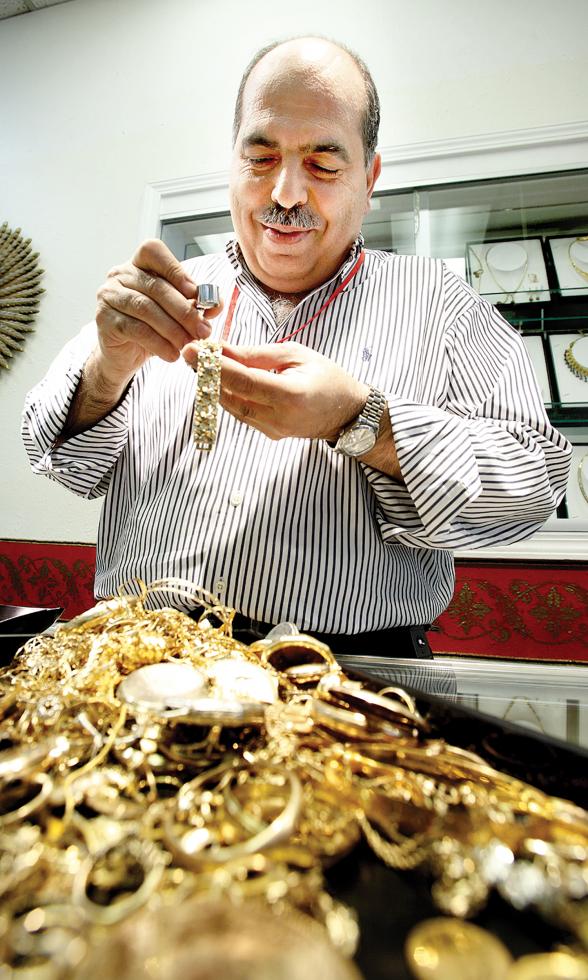Malmud Sharif, owner, Sharif Jewelers

All that glitters is gold in a down market, and in the wake of economic collapse and the sinking Euro, the metal is looking more precious than ever to buyers and sellers of all shades.
Gold, which closed at an all-time high of $1,254 an ounce in mid-May, has been outperforming a host of stocks, bonds and other commodities. And as financial markets across the globe bellyache about debt and insolvency, investors from banks to individuals are buying and selling gold to ease their woes.
Gold is viewed by many as the ultimate safe-haven currency — a hedge against the potential collapse of paper currencies, says one Morgan Stanley Smith Barney adviser who asked not to be named. The Euro crisis has reaffirmed those who believe the viability of paper money could be at stake.
“It’s fear. It’s all fear. It’s just flat fear. It’s like putting money under your mattress,” the adviser says. “It really started big in 2000 with Y2K because people thought the world was going to end, and they wanted something with intrinsic value.”
As a result of that thinking, sales of 1-ounce American Eagle coins from the U.S. Mint increased from 60,500 in April to 190,000 in May amid concerns about the worldwide effect of debt in the European Union. It was the largest lot of coins sold by the mint since January 1999 when it sold 208,500.
Demand for gold has been so high, in fact, that Thomas Geissler, the chief executive of Germany’s Ex Oriente Lux, has created the Gold to Go machine, an ATM that dispenses gold bars and coins in exchange for cash at the Emirates Palace hotel in Abu Dhabi. More vending machines are expected to sprout in Europe and the United Arab Emirates this year.
So what, then, is a gold-coin owner to do with that little glimmering wheel? Sell it.
Given the metal’s strength this year, investors and traders forced to meet margin calls when stocks or other securities take a dive are selling gold to raise cash. And bigwig investors aren’t the only ones.
Mahmud Sharif, owner of Sharif Jewelers in Folsom and Sacramento, says the cash-for-gold portion of his business has exploded the past two years. Historically, the gold buying portion of his 30-year-old business has accounted for about 5 to 10 percent of sales. Now, he says, it’s 60 percent of his business.
“Before, it was people trading in, not for cash, but for something more fashionable. Now, people are digging in their drawers,” he says. “I’m not kidding you, we’re buying dentures and teeth.”
The piles of broken chains, earrings, old watches and coins are purchased by Sharif for 75 to 80 percent of value and sold to a refinery, which will either keep the gold for its own use or resell it back to Sharif in coin or bar form.
Jesse Oxman, owner of Time to Remember Jewelry & Loan in Sacramento, says he sees plenty of gold coins coming through his doors. But when he buys them, it’s not for resale.
“For me, it’s retirement. I save the gold coins and the Morgan silver dollars. I haven’t sold a gold coin in about eight years,” he says. “It’s definitely increased in value and has been a benefit to me. I think my wife and I are going to retire at the end of next year.”
Other than coins, Oxman’s pawn shop has seen lots of jewelry.
“Last month was quite busy. I probably saw close to 300 people selling. Two years ago you would probably see somewhere between 30 to 40 people” in a typical month, he says.
As a result, the supply of scrap gold in the market was up 31 percent in 2009 from the year before, according to a gold industry report released by Morgan Stanley Smith Barney in the third quarter of ’09.
But unless you already have gold stashed in the sock drawer, now is not the time to be pondering its benefits, says Steven Zeller, senior wealth adviser and president of Zeller Kern Private Wealth Management Inc. in Gold River.
“During normal economic cycles, gold can be a great diversifier,” he says. “However, the climate we’re in is deflationary, and we don’t think the worst is over so we question whether gold is a good diversifier in that environment.”
Instead, Zeller recommends diversifying with treasury bills and cash, at least until the metal falls to $700 an ounce.
“We are concerned that [gold prices are] reaching a high, and we like to buy assets when they’re cheap,” he says. “No. 2, you are seeing and hearing commercials for gold every 30 seconds. It’s a mania, so we are avoiding it.”
Recommended For You

Pricing the Past
Collector Brian Witherell on the gambles and gains of antiques
Juxtaposed against the crisp, modern lines of Brian Witherell’s home in Alkali Flat sits a trove of ancient treasures, premier antiquities cherry picked from his company’s massive antique collection.

Money Tree
New Helvetia Hardwoods is homegrown
Tree aficionado Clark Kayler rescues fallen elms, walnuts, sycamores and redwoods — giants that have lined the streets of midtown Sacramento for more than 100 years — and grants them new life in the form of furniture.


